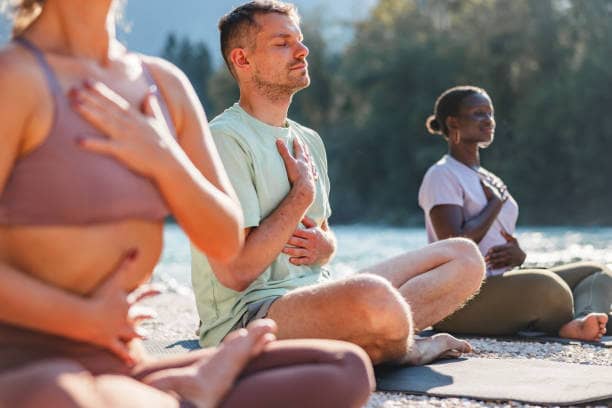Meditation has gained immense popularity in recent years due to its numerous benefits for physical and mental well-being. It is a practice that involves training your mind to focus and redirect your thoughts, leading to a state of relaxation and inner peace. This article will guide you through the basics of meditation, providing practical tips and techniques to help you start your meditation journey right at home.
Understanding Meditation
Before delving into the practical aspects, it’s crucial to understand what meditation truly is. Meditation is not about emptying your mind; it’s about observing your thoughts without judgment. It’s about being present in the moment and connecting with your inner self.
The Benefits of Meditation
- Reduced stress and anxiety: Regular meditation can significantly lower cortisol levels, the stress hormone.
- Improved focus and concentration: Meditation enhances your ability to pay attention and stay focused.
- Enhanced emotional well-being: Cultivating mindfulness can lead to increased emotional stability and resilience.
- Better sleep quality: Meditation can help regulate sleep patterns and promote restful sleep.
- Strengthened immune system: Studies suggest that meditation can boost your body’s natural defenses.
- Increased self-awareness: Meditation helps you understand your thoughts and emotions better.
Getting Started with Meditation
Finding a Quiet Space
- Choose a peaceful environment: Find a quiet room where you won’t be disturbed.
- Create a calming atmosphere: Use soft lighting, gentle music, or aromatherapy to enhance relaxation.
- Prepare your body: Wear comfortable clothing and ensure your body is supported.

Basic Meditation Techniques
- Focused Attention Meditation: This involves focusing on a single point of reference, such as your breath, a mantra, or a specific object.
- Mindfulness Meditation: This technique involves observing your thoughts and feelings without judgment.
- Loving-kindness Meditation: This practice cultivates feelings of love and compassion towards yourself and others.
The Meditation Posture
- Sitting: The most common position, with your back straight and your legs crossed.
- Lying Down: Suitable for beginners or those with physical limitations.
- Walking Meditation: Involves focusing on the sensations of walking.
Common Mistakes and How to Avoid Them
- Expecting perfection: Meditation is a journey, not a destination. Don’t get discouraged if your mind wanders.
- Overthinking: Simply observe your thoughts without getting caught up in them.
- Comparing yourself to others: Everyone’s meditation experience is unique. Focus on your progress.
- Giving up too soon: Consistency is key. Stick with it, and you’ll start noticing benefits.
Incorporating Meditation into Your Daily Life
- Start small: Begin with short meditation sessions and gradually increase the duration.
- Find a consistent time: Establish a regular meditation practice to create a routine.
- Experiment with different techniques: Try different meditation styles to find what works best for you.
- Be patient and kind to yourself: Meditation is a skill that takes time to develop.
- Share your experience: Join a meditation group or discuss your practice with others.
Deepening Your Meditation Practice
- Meditation retreats: Immerse yourself in a dedicated meditation environment for intensive practice.
- Guided meditations: Use audio or video guidance to support your meditation journey.
- Meditation apps: Explore meditation apps for additional tools and resources.
- Mindfulness in daily life: Apply meditation principles to your everyday activities.
Meditation Apps
Meditation apps have revolutionized the way people practice mindfulness. These digital platforms offer a wealth of guided meditations, music, and tools to support your meditation journey. Let’s explore some of the popular options available:
Popular Meditation Apps
- Headspace: Known for its user-friendly interface and vast library of guided meditations, Headspace caters to beginners and experienced meditators alike. It offers programs for stress reduction, sleep improvement, and focus enhancement.
- Calm: Focusing on mindfulness and relaxation, Calm provides a range of guided meditations, sleep stories, and breathing exercises. Its emphasis on creating a calm atmosphere makes it a popular choice.
- Insight Timer: This app boasts a massive collection of free guided meditations from teachers worldwide. With its timer function and community features, Insight Timer offers flexibility and a sense of connection.
- Smiling Mind: Designed for people of all ages, Smiling Mind offers meditations tailored to specific needs, such as parenting, stress management, and children’s well-being.
- Ten Percent Happier: This app combines meditation with practical advice from author Dan Harris. It offers a blend of mindfulness techniques and tools for everyday life.
Choosing the Right App

Selecting the best meditation app depends on your personal preferences and goals. Consider the following factors:
- Guided vs. Unguided Meditation: Some apps focus on guided meditations, while others offer more flexibility for independent practice.
- Content Library: Explore the variety of meditations, music, and additional features offered by different apps.
- User Interface: A user-friendly interface can enhance your meditation experience.
- Cost: Many apps offer free trials or basic features, but some require a subscription for full access.
- Community Features: Some apps include social features or forums to connect with other meditators.
How to Use Meditation Apps Effectively
- Start with a Free Trial: Most apps offer free trials, allowing you to explore different options before committing.
- Set Realistic Goals: Begin with short meditation sessions and gradually increase the duration.
- Experiment with Different Techniques: Try various meditation styles to find what resonates with you.
- Consistency is Key: Make meditation a daily habit for optimal benefits.
- Use Additional Features: Explore other offerings like music, sleep stories, or breathing exercises.
By incorporating meditation apps into your practice, you can access a wealth of resources and support to deepen your meditation journey.
Conclusion
Meditation is a powerful tool for improving your overall well-being. By following the guidance provided in this article, you can start your meditation journey and experience the transformative benefits firsthand. Remember, consistency is key, so be patient and kind to yourself as you embark on this enriching practice.
Discover more from KillCheap
Subscribe to get the latest posts sent to your email.



